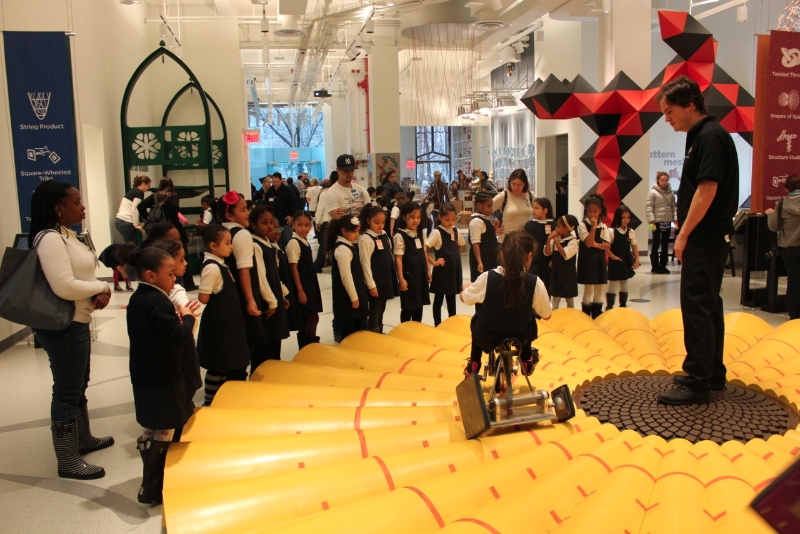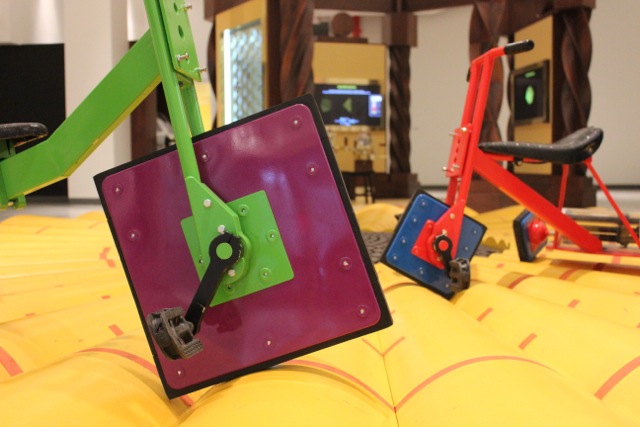My question has to do with the geometry of the square-wheeled tricycle ride Pedal on the Petals at the National Musuem of Mathematics in New York (MoMath).
The tricycles ride on a circular track (see video or pictures below), whose surface forms what I might call a fanned catenary. Note that the inner wheels of the tricycles are smaller squares than the outer wheels, in order that they fit the smaller track length there. Note also that the two rear wheels each have their own axle, and the smaller inner wheel axle is correspondingly lower, although they are geared so that they turn together at the same angular rate. Thus, the two wheels turn in unison, with their corners sinking into the crevices between the catenary pieces at the same time. Another detail is that the turn angle of the tricycle is fixed — the rider cannot steer.
The point of the exhibit, of course, is that despite the square wheels and bumpy road, the tricycles offer a smooth ride around the course. Each axle stays the same distance above the floor as it turns, because the uneven track exactly makes up for the change in the radius of the square as it turns.
My question has to do with the observation that each tricycle operates properly only at a certain fixed radius from the center of the track, namely, the radius at which the circumference of the wheels matches that of the track surface. If you look in the photos, you can see that this radius is marked on the track with a solid red center line for the front wheel and dashed lines for the rear wheels. The wheels have a rubber surface that does not slip on the surface of the track.
Question. Is the geometry of this arrangement stable under small perturbations?
In other words, it seems inevitable that the tricycles will get bumped in some way or pushed a little off their line, and then the wheels will no longer exactly fit the track. Will the precise way that they don't fit tend to force them back onto the track properly?
And what if the fixed angle of the steering is a little off? Will the operation of the tricycle simply force it back into place?
Looking at the operation of the exhibit in practice, it seems to be fairly stable, and I have never seen a rider simply get stuck. I asked the guy running the exhibit at MoMath, but he made only a non-committal answer, although he did suggest that it might be at least a little stable.
I am hoping that someone with a strong geometrical sense will be able to explain to me why the tricycles seem to operate smoothly even when subject to random forces of kids jostling them.






Best Answer
Interesting discussion. As a former MoMath employee, I think I can shed some light here. The short answer is that the trikes' direction and radius are self-maintaining and self-correcting to an extent. The key is that there is some slight slippage of the wheels against the track. The rear wheels will tend to fall into their groove at the same time. If everything is running perfectly, they simply roll into the groove. If not, one or the other will slide a bit to stay in sync. Now imagine the case of being too far from the center of the track. When the rear wheels fall into alignment with a groove, the fixed angle of the steering will cause the front wheel to be pointed not on a tangent to a circular path, but slightly toward the center, setting course for a smaller radius. In the case of the trike riding on too small a radius, often the corners of the rear wheels will not a get a chance to fall into their groove because they meet the next catenary (they are catenaries, by the way.) prematurely. If it's not too far off, the wheel will spin forward and fall into the groove. Usually, if it gets past this point, the self-correcting effect described above will take over (In this case, this means that the fixed-angle steering will the trike away from the center). However, sometimes the corner will hit too high on the curve to slip back and the trike will stop.